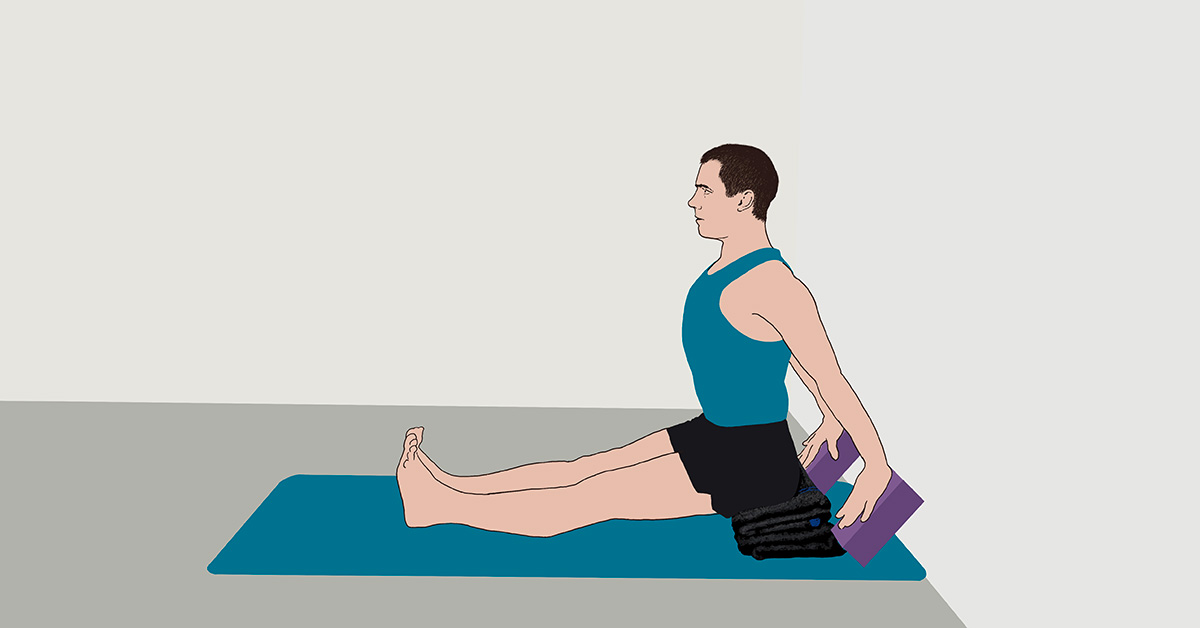For people with stiff or ageing bodies, it’s common to feel that certain types of movement – or even yoga – are no longer accessible. But with the right approach, yoga can be an effective and deeply supportive way to restore mobility, strength, and balance at any stage of life.
This free 65-minute Iyengar Yoga class offers a balanced, whole-body practice designed for stiff or ageing bodies. It includes standing, seated, twisting, and restorative poses, carefully sequenced to improve hamstring and shoulder flexibility, encourage healthy spinal movement, and promote relaxation and postural ease.
Through the use of props such as blocks, belts, bolsters, chairs, and blankets, you’ll learn how to adapt traditional yoga poses to your body – so that even challenging movements become accessible, comfortable, and effective. This supportive, methodical approach helps you build confidence and momentum in your yoga practice while reducing strain and tension.
Whether you’re looking to regain flexibility, improve posture, or simply feel more at ease in your body, this class will guide you through practical techniques for moving with greater comfort and awareness.
Free 65-Minute Iyengar Yoga Class for Stiff or Ageing Bodies

Yoga That Meets You Where You Are
Join Yoga Selection to access guided Iyengar Yoga classes designed for stiff or ageing bodies — with expert instruction, prop-supported sequences, and a library of over 900 on-demand classes.
Your membership gives you full access to every class and course on Yoga Selection.
Accessible. Supportive. Iyengar Yoga for Every Body.
Table of Contents
- Free 65-Minute Iyengar Yoga Class for Stiff or Ageing Bodies
- Sequence Overview: 16 Accessible Poses
- 1. Vajrasana – Establishing Postural Awareness
- 2. Adho Mukha Virasana – Supported Forward Bend
- 3. Uttanasana – Standing Forward Bend (Hands on Blocks)
- 4. Ardha Uttanasana – Half Uttanasana (Hands on Wall)
- 5. Reclining Urdhva Hastasana – Reclined Over Blocks (Belt at Wrists)
- 6. Sirsasana Preparation with Chair (For Shoulder Opening)
- 7. Utthita Hasta Pādānguṣṭhāsana I (Supported with Bolster, Belt & Chair)
- 8. Utthita Hasta Pādānguṣṭhāsana II (For Groin/Adductor Mobility)
- 9. Pārśvottānāsana (Supported with Chair)
- 10. Śalabhāsana (Locust Pose – Belt Around Wrists)
- 11. Uṣṭrāsana (Camel Pose – Supported with Chair)
- 12. Bharadvājāsana (Chair Twist Version for Stiff or Ageing Bodies)
- 13. Daṇḍāsana (Staff Pose) – Supported Version
- 14. Supta Pādānguṣṭhāsana I (Belt Support)
- 15. Supta Pādānguṣṭhāsana II (Lateral Variation)
- 16. Śavāsana (Supported with Bolster Under Knees)
- FAQs
Sequence Overview: 16 Accessible Poses
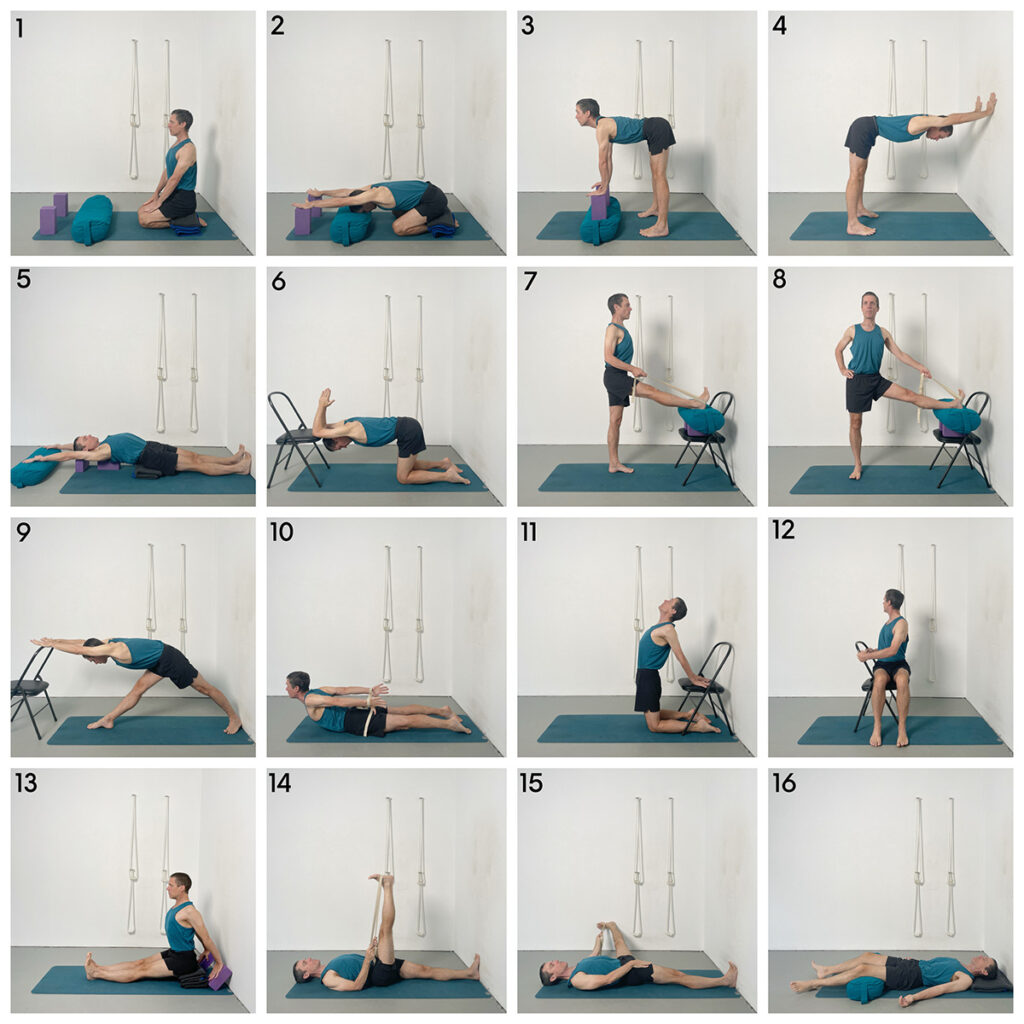
Use this grid as a quick visual map of the Yoga for Ageing or Stiff Bodies sequence. Scroll down for a brief description and step-by-step instructions for every pose.
1. Vajrasana – Establishing Postural Awareness
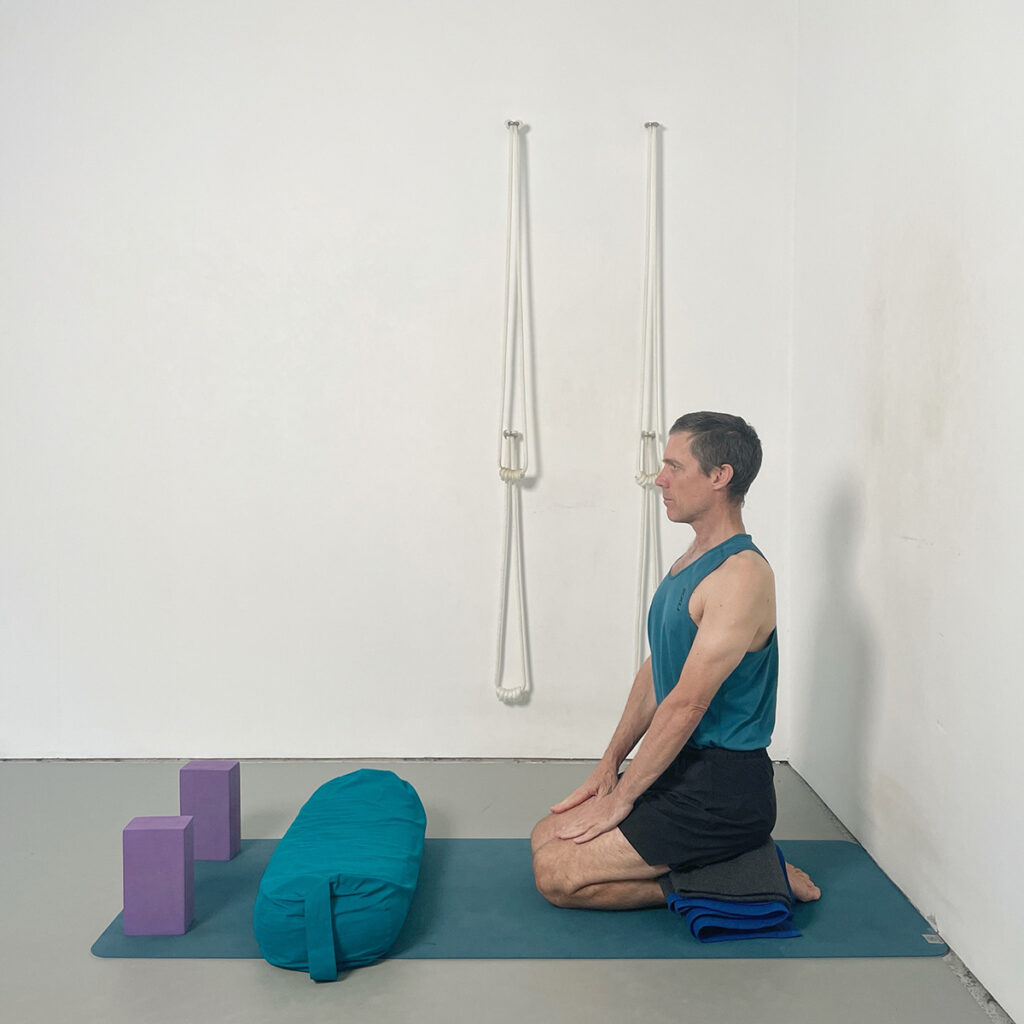
This opening position lays the foundation for the class. Kneeling in an upright position helps you become more aware of basic postural reference points – the alignment of your shoulders chest and spine, and the balance between lift and stability. It’s an opportunity to bring awareness to your body’s vertical axis and to establish steadiness before beginning movement.
Instructions
- Kneel with your knees and feet together, sitting upright on your heels.
- A folded blanket between the buttocks and heels reduces knee strain and makes deep kneeling more accessible.
- Allow the tops of your feet to rest flat on the mat and spread your toes evenly.
- Press your hands against your thighs to generate lift in your spine and chest.
- Lift your spine upward, while keeping the shoulders relaxed.
- Broaden your chest and move your shoulder blades in and down.
2. Adho Mukha Virasana – With Supports
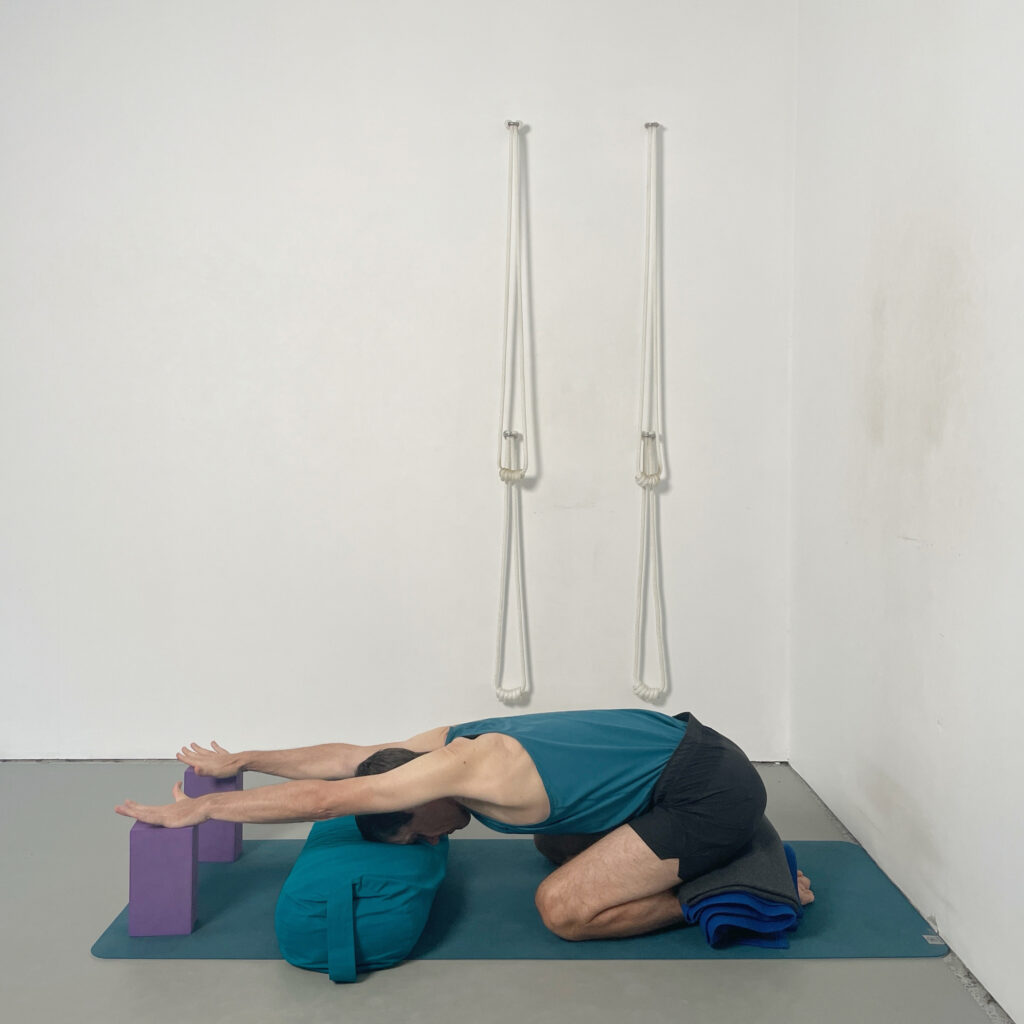
This supported version of Adho Mukha Virasana creates a gentle forward release while supporting the spine, shoulders, and hips. The use of props allows the body to soften without strain, helping to quiet the nervous system and bring ease to the breath.
Instructions
- Kneel with your knees apart and feet together, placing a folded blanket under your hips for support.
- Position a bolster across the mat in front of you and place two blocks beyond the bolster.
- Lean forward and rest your forehead on the bolster, extending your arms to place your hands on the blocks.
- Press your hands onto the blocks to straighten and lift your elbows.
- Keep the buttocks anchored back onto the blanket and the spine lengthening forward evenly.
- Rest the forehead on the bolster to soften the neck and trapezius.
3. Uttanasana – Standing Forward Bend with Hands on Blocks
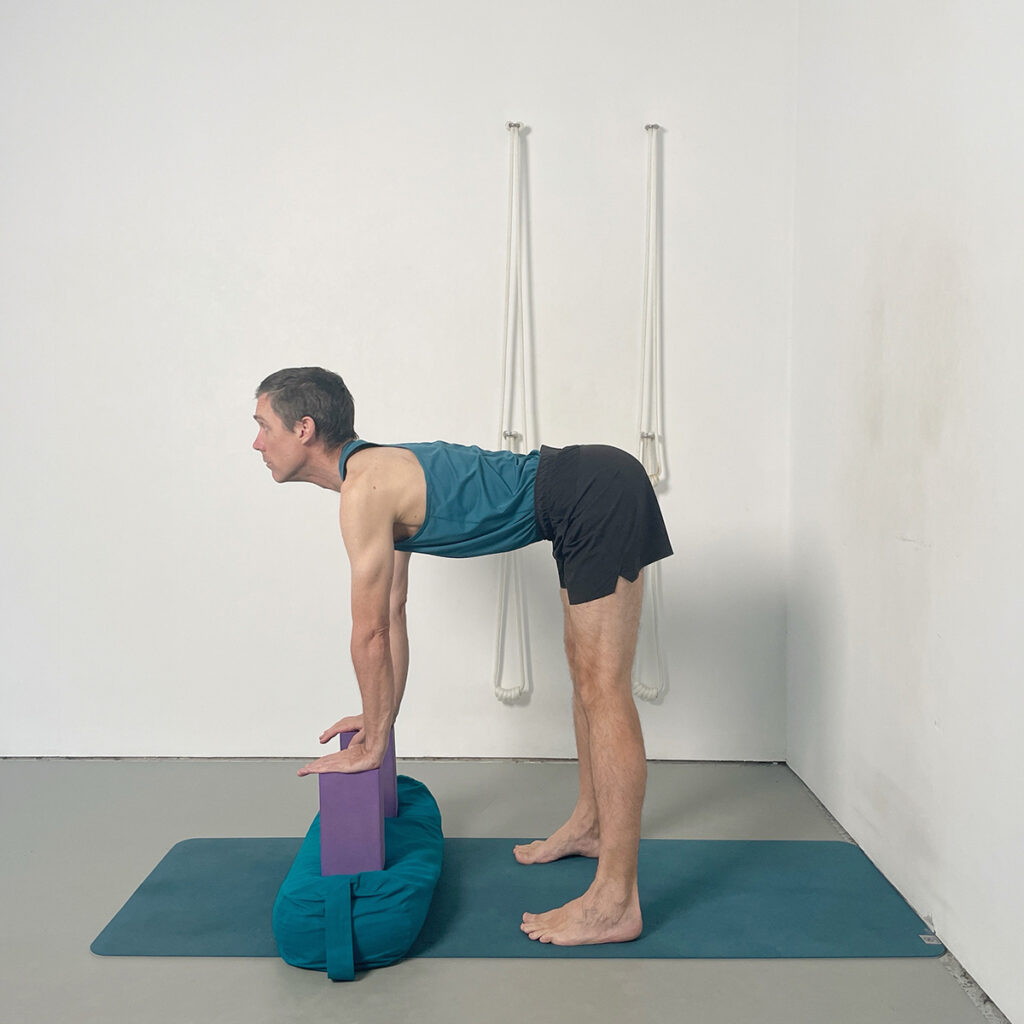
This supported version of Uttanasana lengthens the spine and hamstrings while preventing strain. Working with blocks enables practitioners with tighter hamstrings or stiffer backs to experience forward extension without rounding the spine.
Instructions
- Stand with your feet hip-width apart, placing a pair of blocks shoulder-width apart in front of you.
- Bend forward from the hips and place your hands on the blocks, adjusting their height to allow the spine to stay long and straight.
- Press the feet firmly into the mat, lifting the kneecaps and keeping both legs straight.
- Broaden across the collarbones and draw the shoulder blades into the back to extend the chest forward.
- Lengthen forwards from the pubic bone to the navel, and from the navel to the breastbone.
4. Ardha Uttanasana – Half Uttanasana with Hands on Wall

This variation of Ardha Uttanasana provides support for the spine while accommodating stiffness in the hamstrings. Bringing the hands to the wall allows the practitioner to maintain spinal length and alignment without rounding the back or collapsing the chest.
Instructions
- Stand facing a wall, placing your hands on the wall at hip height with fingers spreading.
- Step back until your arms and torso form a straight line, parallel to the floor.
- Keep your feet hip-width apart, with the inner edges of the feet parallel and toes pointing straight ahead.
- Firm the thighs and lift the kneecaps, keeping both legs straight and active.
- Move the hips back and the chest forward.
- Position your head so that your ears align with the upper arms, looking directly down toward the floor.
5. Reclining Urdhva Hastasana – Reclined Over Blocks
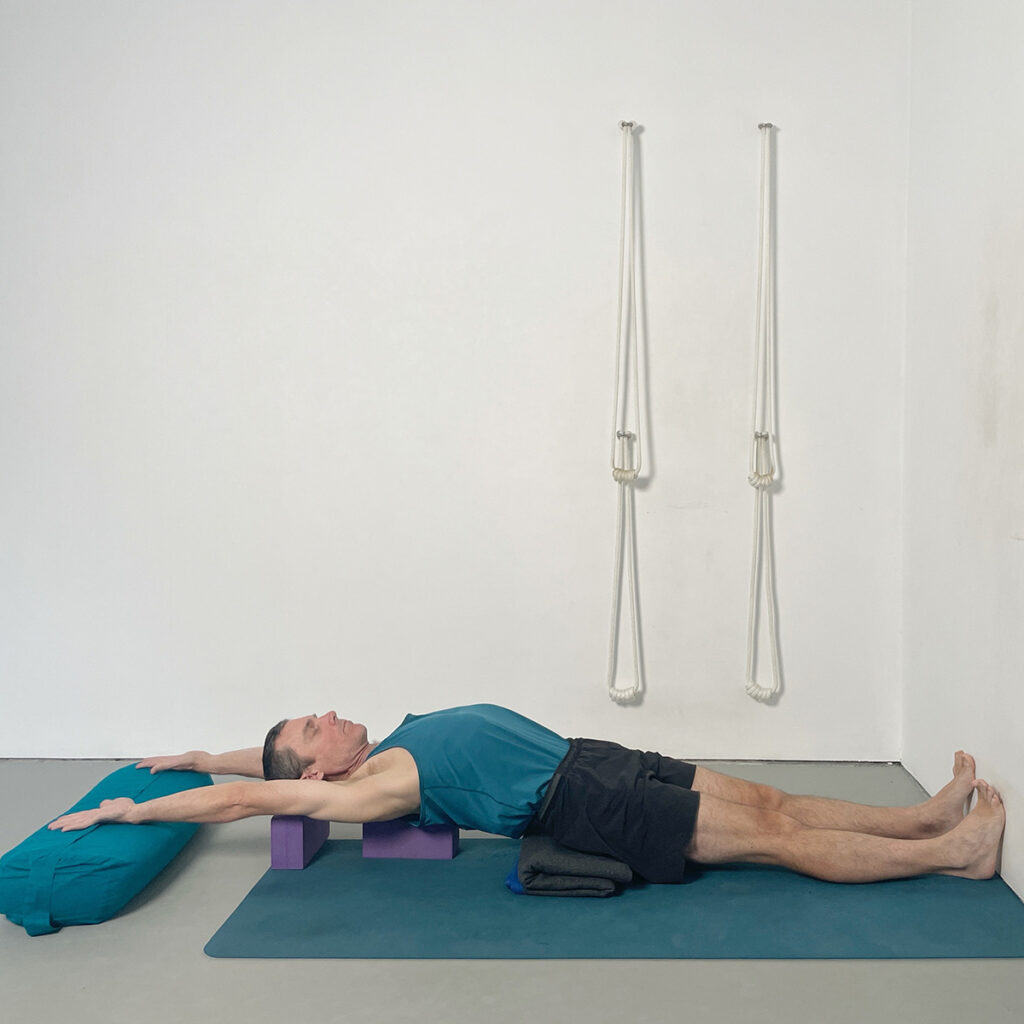
A supported, reclining take on Urdhva Hastasana that targets mobility in the upper back and shoulders. Sitting on a three-fold blanket and lying back over two blocks with a belt around the wrists creates lift through the chest while keeping the neck and lower back comfortable – excellent for postural re-education.
Instructions
- Sit on a 3-fold blanket with feet at the wall, then lie back over two blocks: one in the upper back (near to the base of the neck) and one under the head.
- Place a bolster on the floor behind you so the backs of the wrists/hands can rest on it when the arms go overhead.
- Make a shoulder-width loop with the belt and place it around both wrists; press out into the belt to keep elbows straight.
- Keep the legs straight, big-toe bases pressing into the wall; front thighs descending and the back of the pelvis tucking under for lower-back ease.
- Take the arms back until the backs of the wrists/hands rest on the bolster, maintaining elbows straight and a light contact of the back of the skull on the head block; neck and throat relax, trapezius soft.
- Gently slide the wrists outward along the bolster (as if someone were drawing the arms toward the center of the room) while keeping the chest open and the face relaxed.
6. Sirsasana Preparation with Chair (For Shoulder Opening)
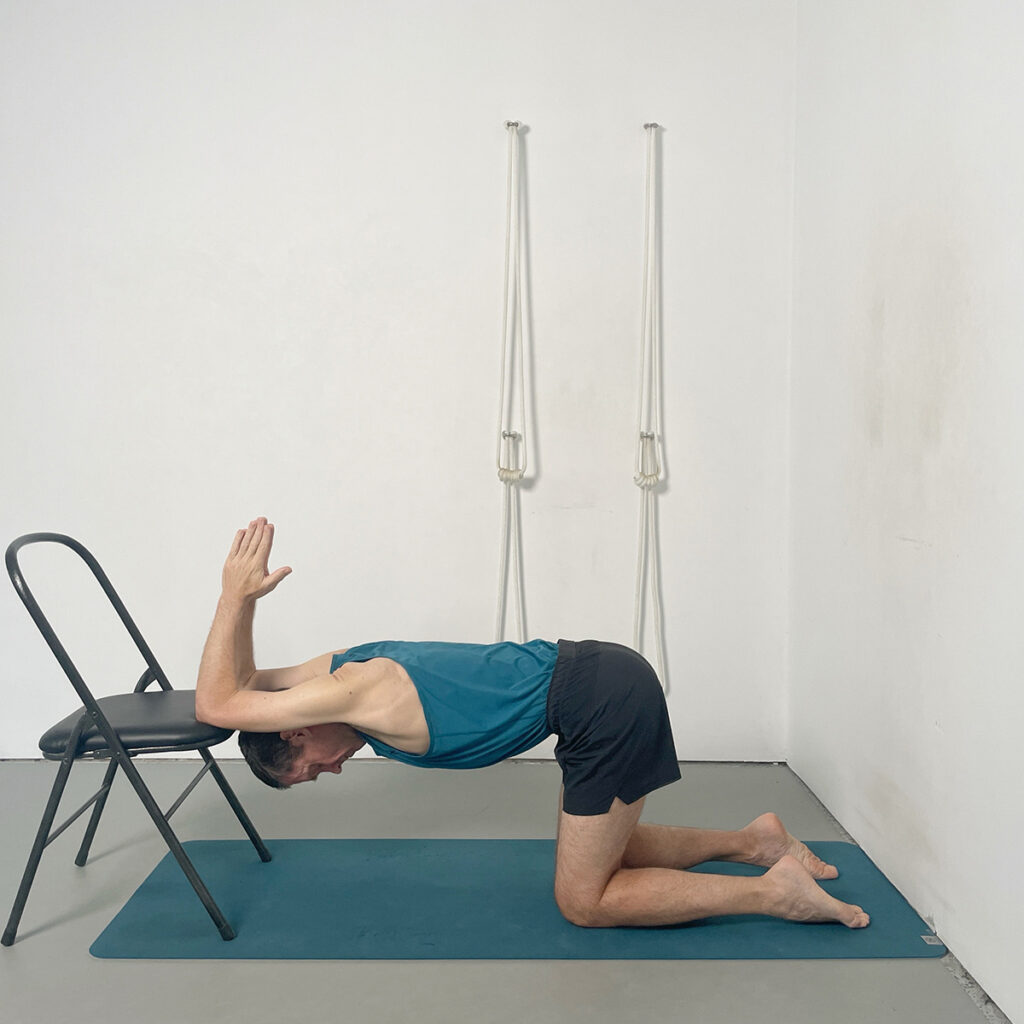
From kneeling, the elbows rest on the seat of a chair to open the shoulders and upper back. This supported setup helps release shoulder stiffness and neck tension.
Instructions
- Place a chair at the end of your mat; come to kneeling and place elbows near the edge of the seat, palms together, fingers pointing up.
- Walk the knees back under the hips; rest the forehead on the seat to begin.
- If mobility allows, let the head hang between the upper arms; if the opening is too intense, return the forehead to the seat.
- Avoid pressing the elbows down; this allows the shoulders to release downwards and outwards.
- Keep the front body long: from elbows through chest and abdomen, letting the pubic bone move away from the navel; avoid collapsing the diaphragm region.
- Fine-tune the pelvis so the sitting bones aim straight back to the wall (not up or down).
7. Utthita Hasta Pādānguṣṭhāsana I (Supported with Bolster, Belt & Chair)
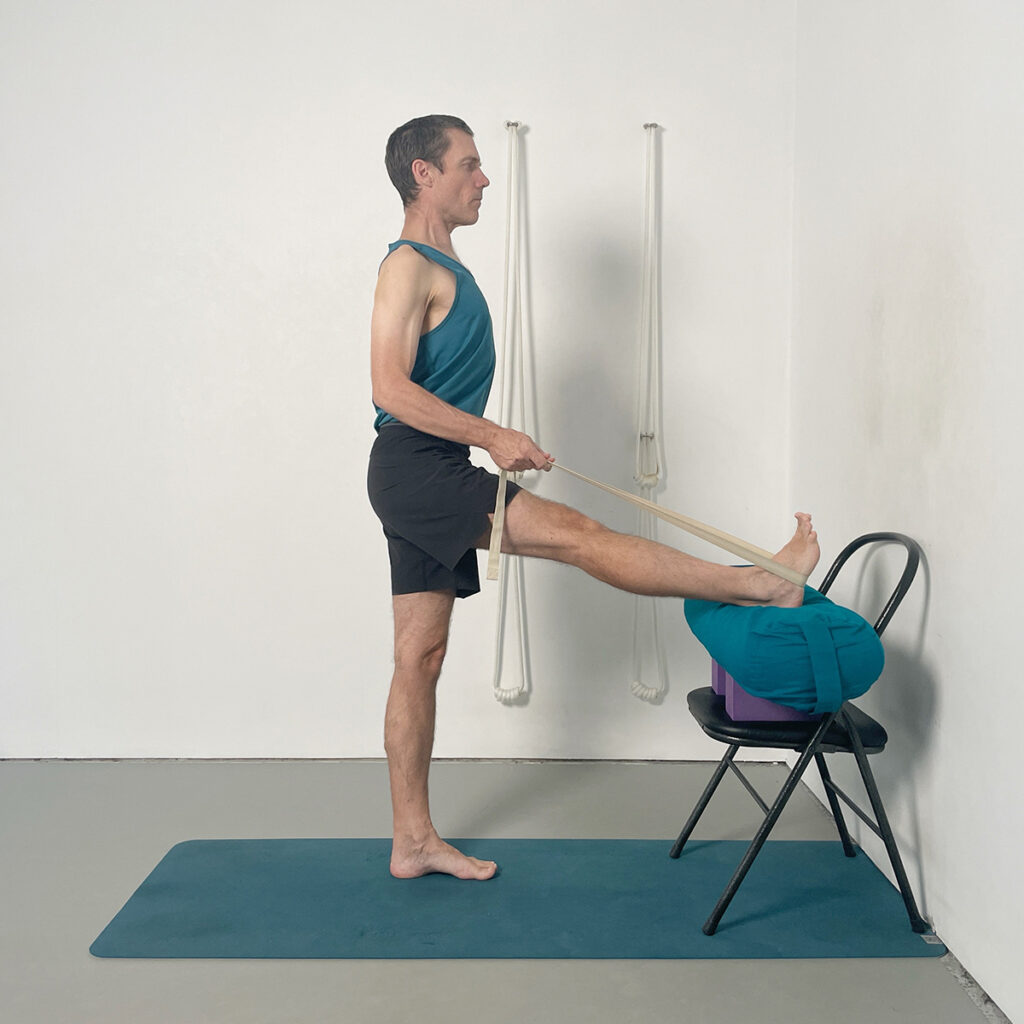
A standing hamstring opener modified for stiff bodies using a chair, bolster and a belt. This variation lets you stand upright, with your chest open, and spine supported whilst lengthening the hamstrings.
Instructions
- Place a chair at the wall with a bolster on the seat (adjust height with blocks if needed).
- Stand on the left foot and place your right heel onto the centre of the bolster.
- Place the belt under the ball of the right foot, holding the belt in both hands. Stand upright with shoulders over hips.
- Stabilise the standing leg: Left big-toe base press down, left knee straight, left inner groin moves back.
- Balance the hips: Keep the right hip down so the hips stay level.
- Create lift with the belt: Resist with the right foot and pull the belt, roll shoulders back, draw shoulder blades in, and lift the chest and spine upwards.
- Bent elbow option: Slide the hands back along the belt to bend the elbows by the ribs for added chest lift.
8. Utthita Hasta Pādānguṣṭhāsana II (For Groin – Adductor Mobility)
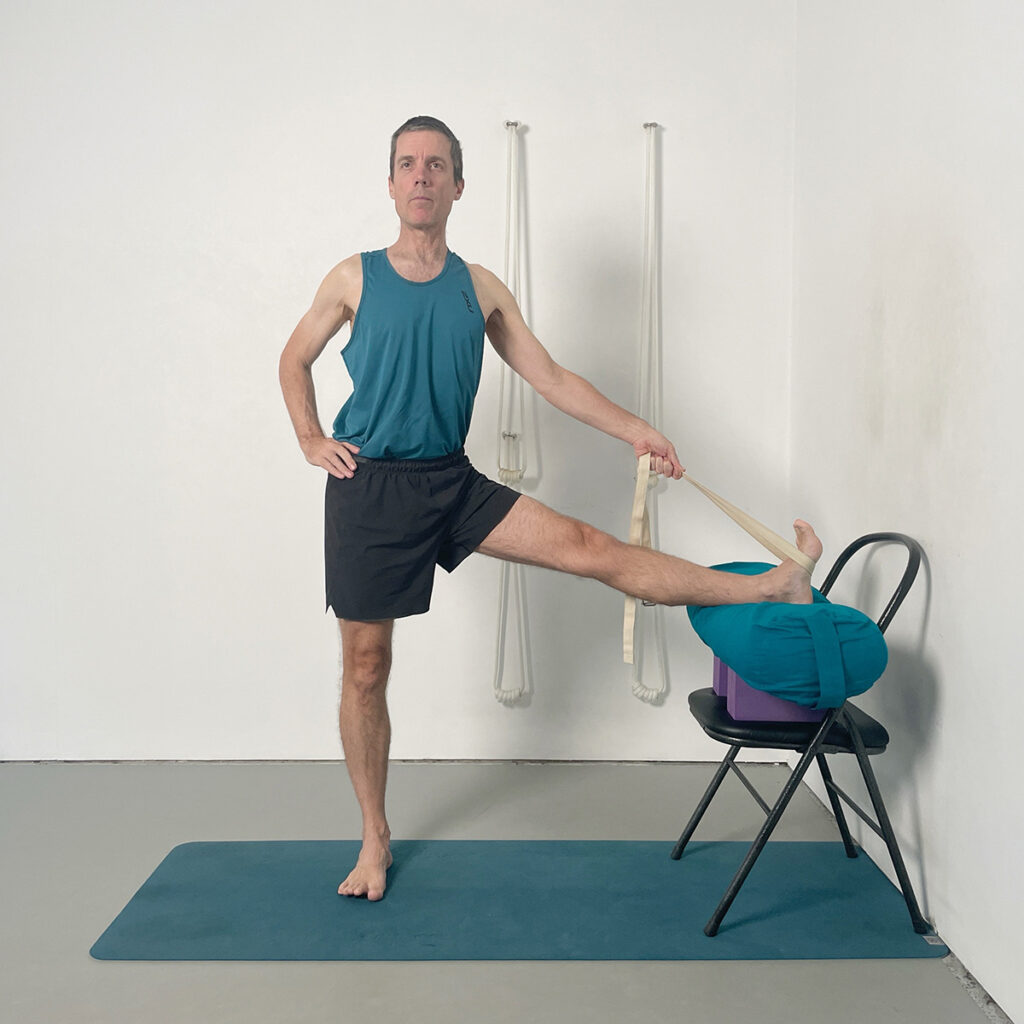
This second variation of Utthita Hasta Pādānguṣṭhāsana shifts the focus from the hamstrings to the inner thigh and groin. It’s a supported standing pose that improves adductor mobility.
Instructions
- Place a chair near the wall with a bolster on the seat (adjust height as needed).
- Stand on your left foot and place the right heel on the bolster so the leg extends out to the side.
- Loop a belt under the ball of the right foot, hold the belt in your right hand. Keep the left hand on the left hip.
- Stabilise the standing leg: Left big toe base presses down, left knee straight, and front thigh firm.
- Move the right buttock and right outer thigh down.
- Lift the right chest upwards and forwards, keeping the left shoulder back.

Yoga That Meets You Where You Are
Join Yoga Selection to access guided Iyengar Yoga classes designed for stiff or ageing bodies — with expert instruction, prop-supported sequences, and a library of over 900 on-demand classes.
Your membership gives you full access to every class and course on Yoga Selection.
Accessible. Supportive. Iyengar Yoga for Every Body.
9. Pārśvottānāsana (Supported with Chair)
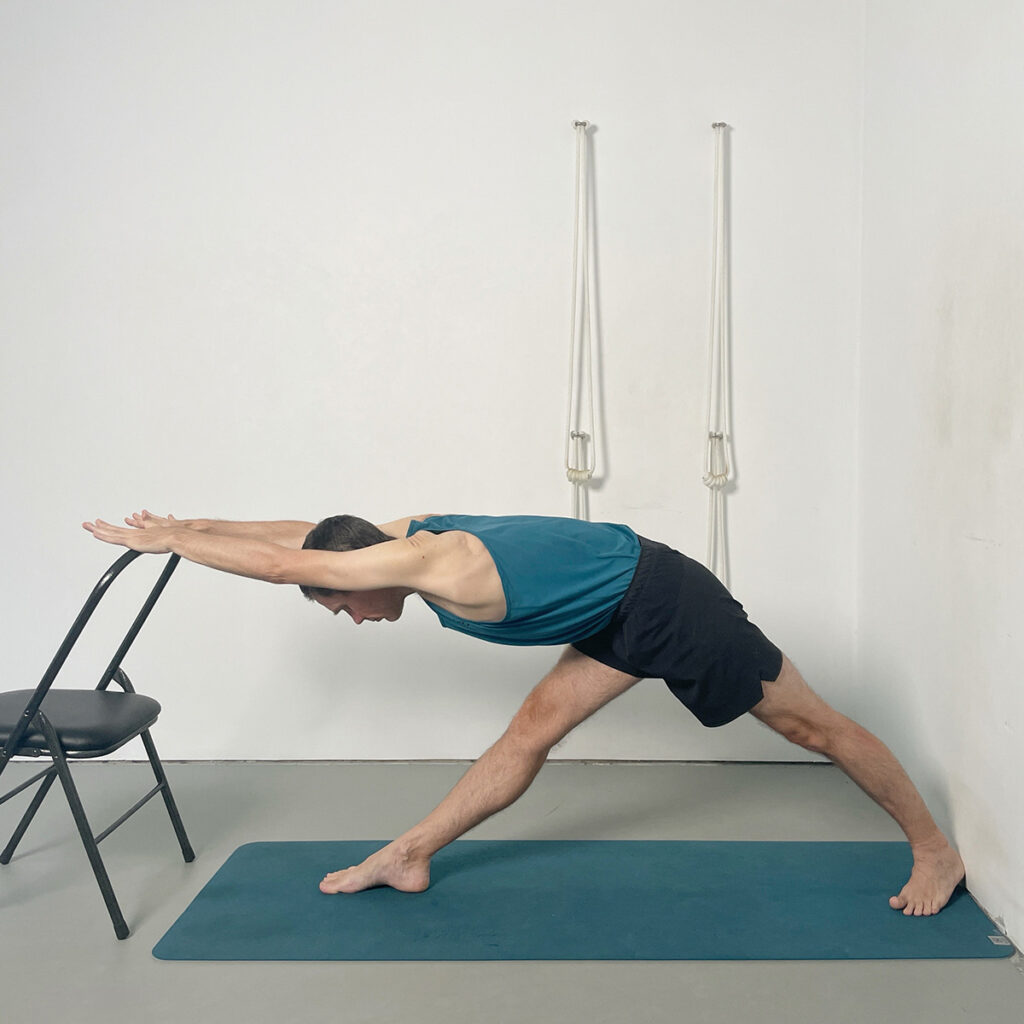
This supported variation of Pārśvottānāsana is ideal for those with tight hamstrings or limited forward-bend mobility. The use of a chair allows the spine to stay long and supported, while also providing a mild shoulder-opening action.
Instructions
- Set up: Place a chair facing you at the end of the mat..
- Stand with the right foot forward and the left foot back, keeping both legs straight and the hips facing the chair.
- Place the palms flat on the top of the chair, fingers pointing forward, keeping the arms straight.
- Lengthen and straighten the line from wrists, through the shoulders and back to the hips.
- Press the front big-toe mound and outer back heel to stabilise the pelvis.
- Whilst in the pose, push the chair away from the body to further open the chest and lengthen the spine.
10. Śalabhāsana (Locust Pose – Belt Around Wrists)

In this supported variation of Śalabhāsana, a belt is looped around the wrists to help engage the shoulders and open the chest more effectively. It strengthens the back body, improves postural awareness, and helps to counteract rounded shoulders from prolonged sitting.
Instructions
- Set up: Lie face down on your mat, optionally with a thin blanket under the front of the pelvis for cushioning.
- Loop the belt: Make a shoulder-width loop with the belt and place it around both wrists behind your back, with the palms facing each other and thumbs pointing down.
- Keep the tops of the feet pressing into the mat, knees straight, and legs active.
- Initiate the lift: Press the wrists out into the belt, then lift the head, shoulders, chest, and arms off the floor, keeping the feet grounded.
- Broaden the chest: Draw the shoulder back and the shoulder blades into the body, lift the sternum forwards and upwards.
- Chest and spine move forwards whilst drawing the arms and legs back.
11. Uṣṭrāsana (Camel Pose – Supported with Chair)

This supported version of Uṣṭrāsana uses a chair as a prop to make the backbend more accessible while allowing deeper focus on upper back mobility, shoulder opening, and chest expansion. It’s particularly beneficial for improving posture and counteracting kyphosis or upper-back rounding.
Instructions
- Place a chair against the wall, with the seat facing you and the backrest touching the wall for stability.
- Kneel on your mat facing away from the chair, with the toes pointing back and knees hip-width apart.
- Reach back and place your hands on the seat of the chair, fingers pointing toward the wall and thumbs turning slightly outward.
- Press the fronts of the shins down to keep the thighs vertical and the hips over the knees.
- Lift through the chest: As you press your hands into the chair, move the shoulder blades and into the back, lifting and broadening the upper chest.
- Open the front body: Keep the lower back long as the sternum lifts upward, collarbones spread wide, and neck lengthens to look gently upward.
12. Bharadvājāsana (Chair Twist Version for Stiff or Ageing Bodies)
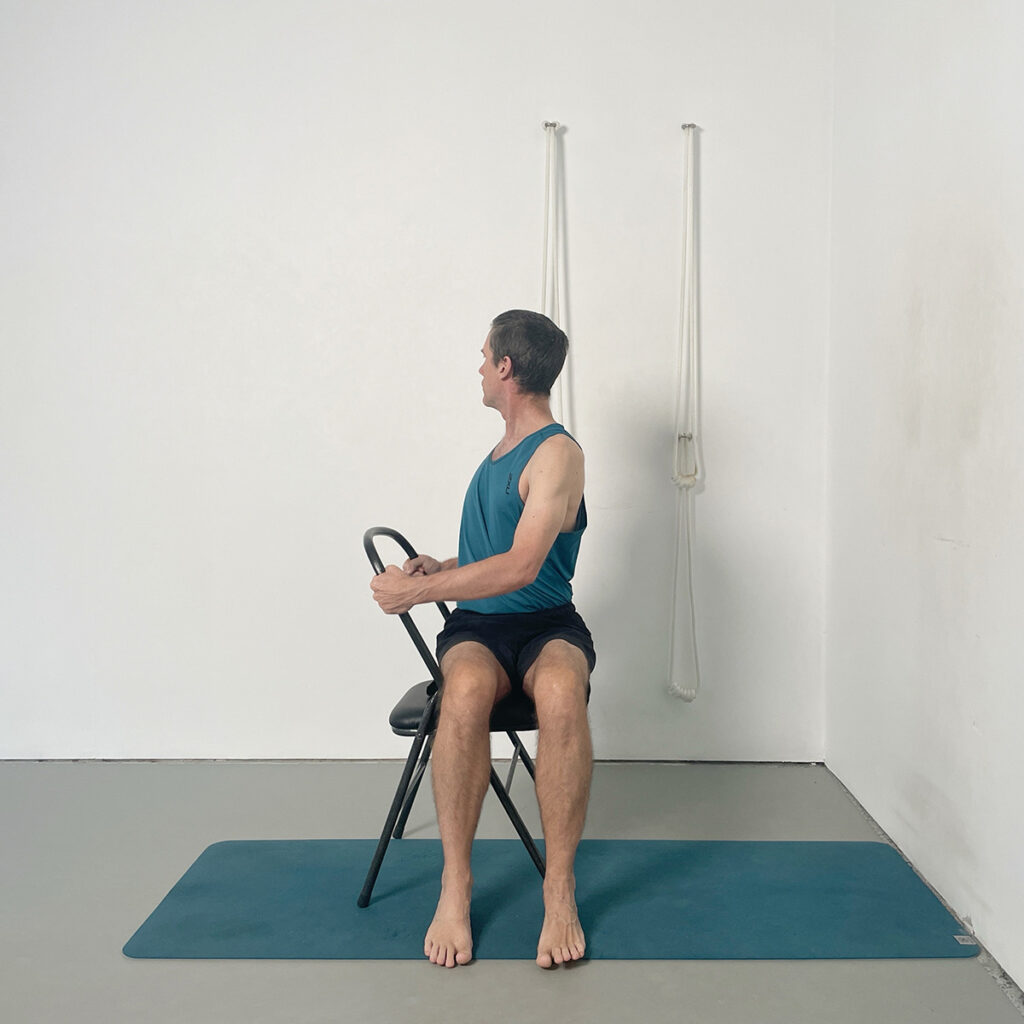
This supported version of Bharadvājāsana is performed seated sideways on a chair, making it ideal for those with a stiff or tight back. The support of the chair enables a steady, balanced twist that helps release tension, mobilise the spine, and improve posture.
Instructions
- Sit sideways on the seat, with the right hip lightly touching the chair’s backrest.
- Position the legs: Keep both feet flat on the floor, knees hip-width apart, and ankles directly under the knees.
- Hold the chair: Take hold of the backrest with both hands, adjusting your grip so the shoulders can stay down and broad.
- Initiate the twist: On an exhalation, turn the chest toward the chair’s backrest, allowing the shoulders to follow.
- Ground the legs: Keep the feet evenly pressing down and the knees level to prevent the pelvis from turning.
- Deepen gradually: With each breath, lengthen the spine upward as you gently increase the twist, turning the ribcage and chest rather than forcing the lower back.
13. Daṇḍāsana (Staff Pose) – Supported Version for Stiff or Ageing Bodies
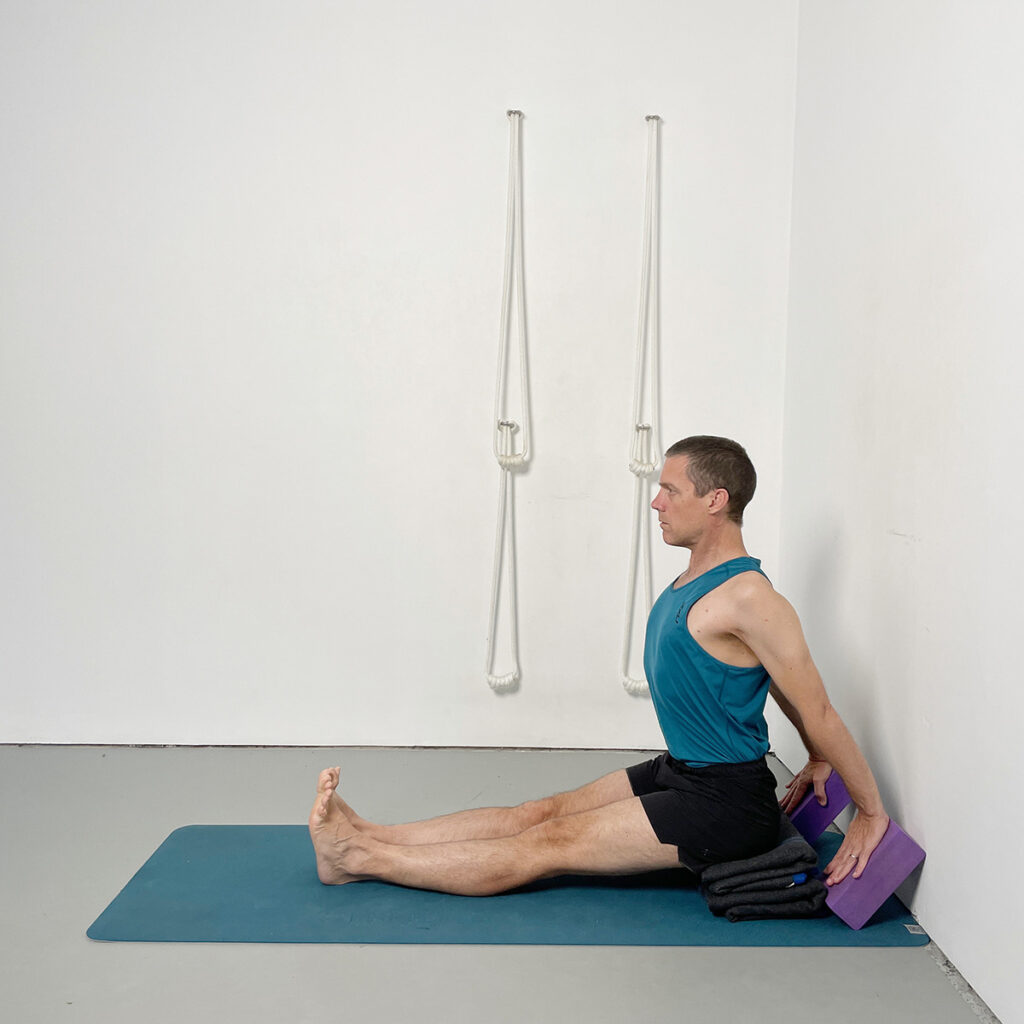
This supported version of Daṇḍāsana is designed for people with limited mobility or stiffness in the hamstrings and lower back. By using folded blankets and blocks, it allows you to experience the key benefits of the pose—spinal lift, chest opening, and postural awareness—without strain.
Instructions
- Sit on one or more folded blankets with your legs extended straight out in front of you.so that your
- Sufficient blanket height will allow you to move the back of your pelvis in, and lift your lower back up.
- Place a block beside each hip and press your hands onto the blocks. This gives leverage to help lift the spine.
- Ground the legs: Press your thighs down and extend your heel forwards.
- Lengthen the spine: Use the support of your hands to lift the sides of the chest and elongate the spine upward from the base to the crown of the head.
- Broaden the chest: Roll the shoulders back and down, moving the sternum forwards and upwards.
14. Supta Pādānguṣṭhāsana I (Reclining Hand-to-Big-Toe Pose – Belt Support)
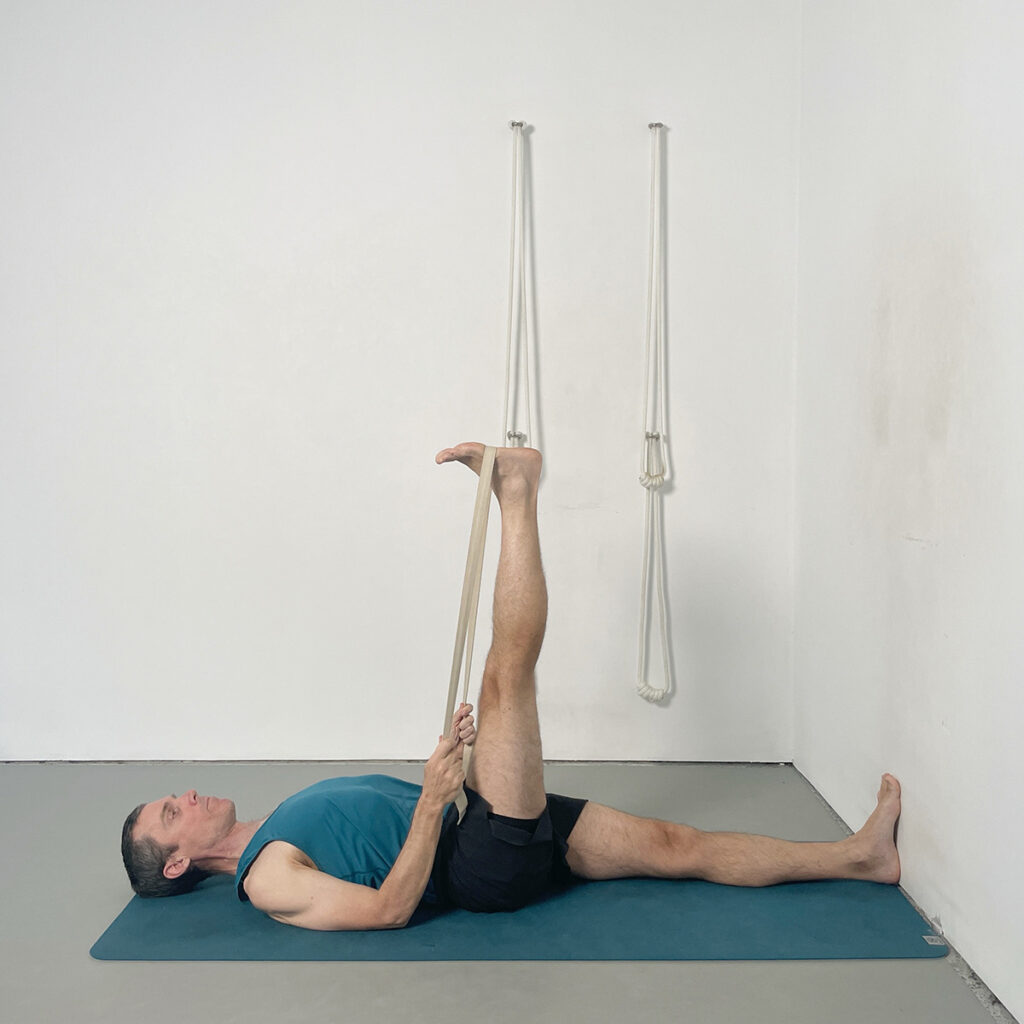
In this first variation of Supta Pādānguṣṭhāsana, the belt provides a controlled way to lengthen tight hamstrings while the floor supports the back and spine.
Instructions
- Lie flat on your back with the legs extended and a belt nearby.
- Bend your right knee and place the belt around the ball of the right foot, holding the belt with both hands.
- Extend the leg: Gradually straighten the right leg upward.
- Ensure that the hips remain level.
- Ground the other leg: Keep the left leg active, pressing the thigh down and the heel into the wall.
- Open the chest: Press the shoulders down into the floor and lift the shoulder blades up into the body, allowing the chest to broaden as you lengthen evenly through both sides of the torso.
15. Supta Pādānguṣṭhāsana II (Reclining Hand-to-Big-Toe Pose – Lateral Variation)
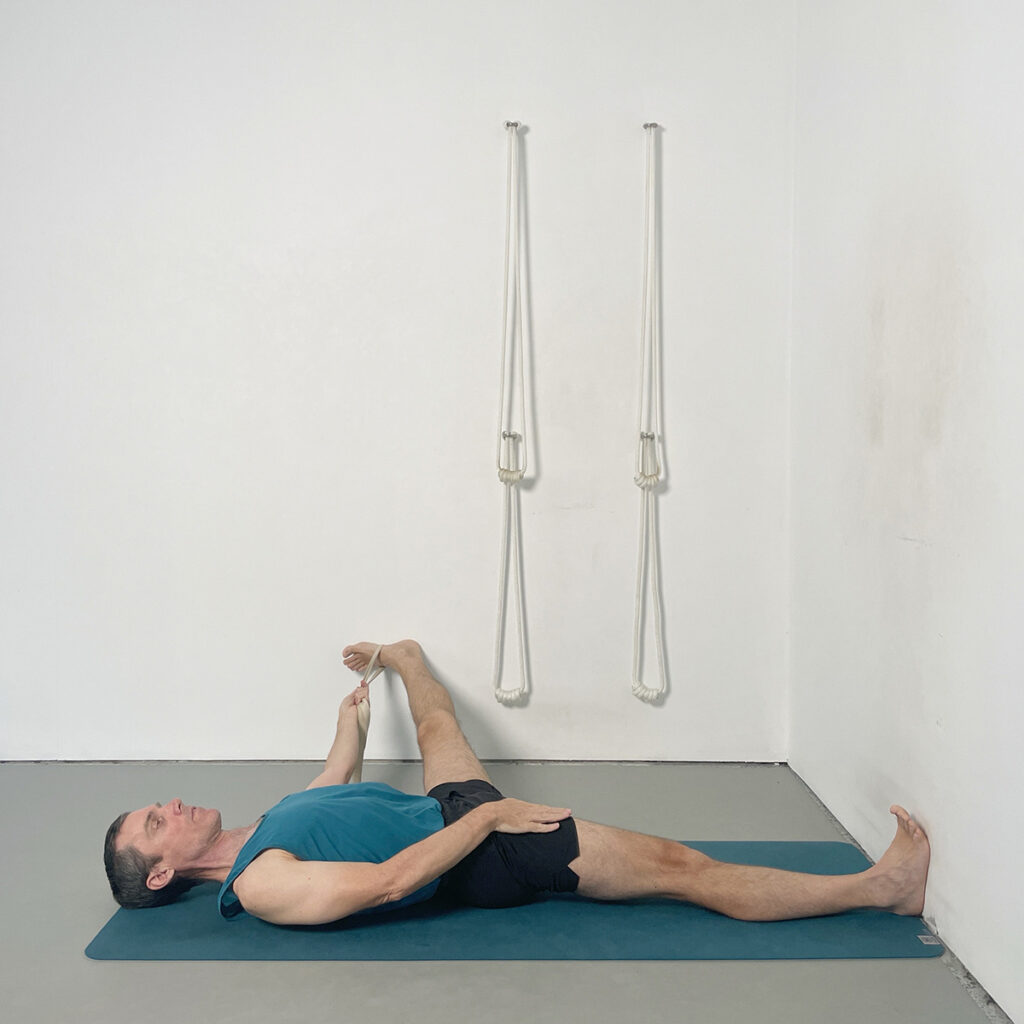
This second variation of Supta Pādānguṣṭhāsana develops the work of the first but introduces adductor and groin lengthening as the lifted leg opens out to the side. The floor supports the back and pelvis, making it a safe and effective way to explore inner thigh mobility without compromising spinal alignment.
Instructions
- Lie on your back with a belt around the ball of your right foot, holding the belt in the right hand.
- Stabilise the base: Press the left thigh down and the left heel firmly into the wall.
- Bring the right leg down and out to the side, keeping the left thigh and left shoulder grounded.
- Resist with the belt whilst pressing the right foot into the belt to further descend the left thigh.
- Broaden the right side of the chest, whilst anchoring the left shoulder.
- Stay and breathe: Hold for several smooth breaths.
16. Śavāsana (Corpse Pose – Supported with Bolster Under Knees)
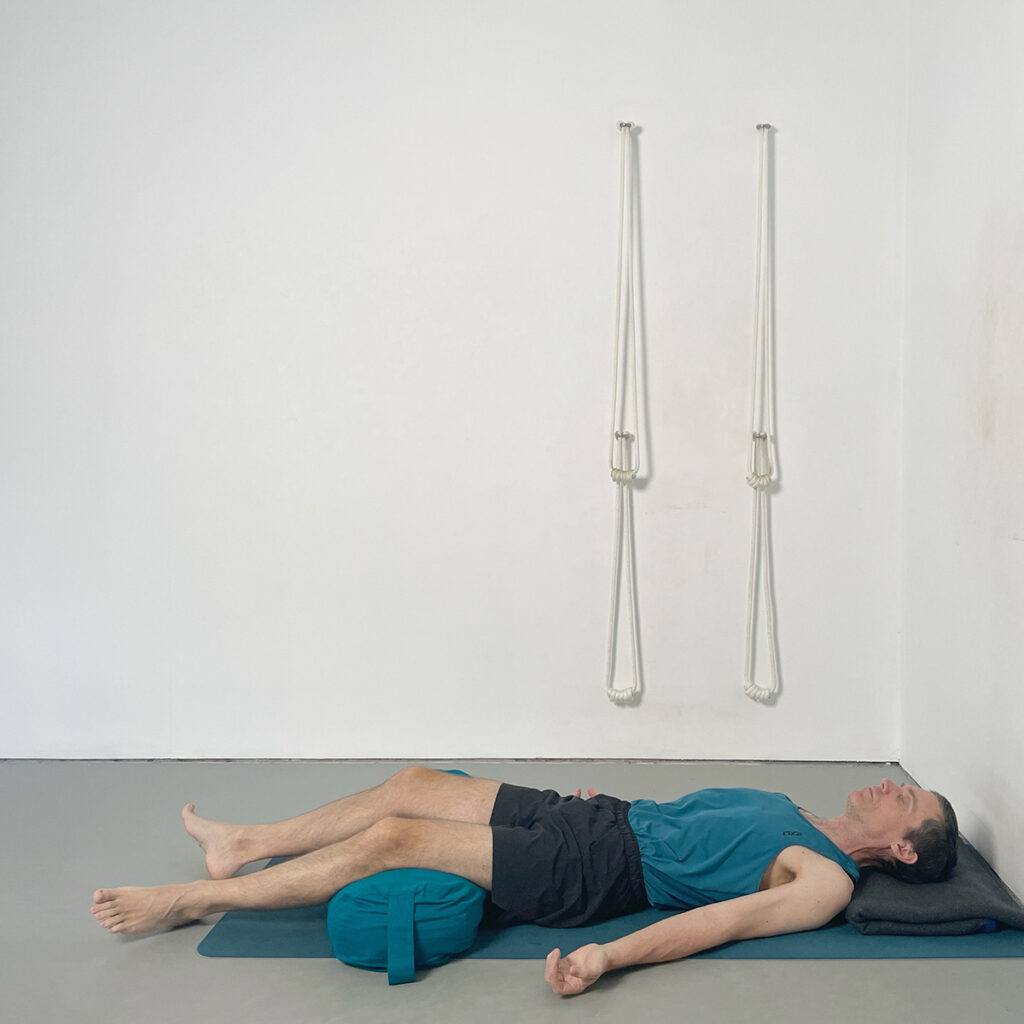
In this supported version of Śavāsana, a bolster is placed beneath the backs of the knees to slightly bend the legs and ease tension in the lower back. This gentle modification is particularly helpful for alleviating lumbar discomfort and creating a deeper sense of rest and balance in the body after practice.
Instructions
- Lie flat on your back with a bolster placed under the knees, allowing the legs to bend softly and the thighs to release.
- Adjust the head and neck: Use a folded blanket under the head to ensure that the chin and forehead remain level.
- Place the arms comfortably away from the body, palms turned upward, allowing the shoulders to release towards the floor.
- Soften the back: Let the lower back settle towards the floor, noticing how the bolster helps reduce any arching or strain in the lumbar area.
- Quiet the breath: Bring attention to the exhalation, allowing it to become longer and smoother, helping the body and mind to release residual effort.
- Rest deeply: Remain for several minutes, cultivating a sense of quiet stillness and ease.
FAQs
1. Who is this class for?
People who feel stiff, are returning to yoga after a break, or prefer a gentler, well-supported practice. Beginners are welcome.
2. Do I need a membership to watch the video?
No. The full 65-minute class is included on this page for everyone to follow along – no membership required.
3. What props do I need?
Ideally: a yoga chair, 2 blocks, a belt, a bolster, and 2–3 blankets. If you’re missing something, see the substitutions below.
4. What can I use if I don’t have all the props?
- Chair → a sturdy, backless dining chair (no wheels)
- Bolster → a sofa cushion or pillow
- Blocks → stable books
- Belt → a strap, scarf, or long towel
5. Can I do this class with hamstring tightness?
Yes – the sequence intentionally uses wall, blocks, belt, and chair to make forward bends and other potentially challenging poses accessible while protecting the back.
6. What if I experience discomfort?
Ease off, add height or support, or shorten the hold. Discontinue anything that causes sharp or increasing pain. If you have an injury or medical condition, seek guidance from a healthcare professional before practising.
7. Can I combine this with other Yoga Selection classes?
Yes. Pair it with restorative or other gentle sequences on alternate days. Members also have access to the full library of classes and courses for progressive next steps.
Conclusion: Keep Building Ease and Mobility
This sequence showed how Iyengar Yoga can make practice accessible for stiff or ageing bodies. With thoughtful prop use and clear reference points, poses that once felt out of reach can become comfortable and effective.
Next Steps: When ready, explore our beginner pathway and targeted sequences for hamstrings and shoulders.
Your free trial includes all courses and 900+ classes, so you can keep building mobility and confidence step by step.

Yoga That Meets You Where You Are
Join Yoga Selection to access guided Iyengar Yoga classes designed for stiff or ageing bodies — with expert instruction, prop-supported sequences, and a library of over 900 on-demand classes.
Your membership gives you full access to every class and course on Yoga Selection.
Accessible. Supportive. Iyengar Yoga for Every Body.
Related Practice:
Yoga at Home – A Beginner Iyengar Sequence Without Props

Rod Stennard – Founder of Yoga Selection
Rod Stennard is the founder of Yoga Selection, the first online yoga platform dedicated entirely to Iyengar Yoga. A certified Iyengar Yoga teacher since 2002, Rod has practiced yoga since 1992 and studied under senior teachers from around the world, including members of the Iyengar family in Pune, India.
Rod launched Yoga Selection in 2016 to bring structured, high-quality Iyengar Yoga training to a global audience. As a pioneer in the field of online yoga education, he is passionate about making this method accessible to all, through rigorous, inclusive, and thoughtfully designed classes. His work continues to support students of all levels in over 50 countries.
Share:
